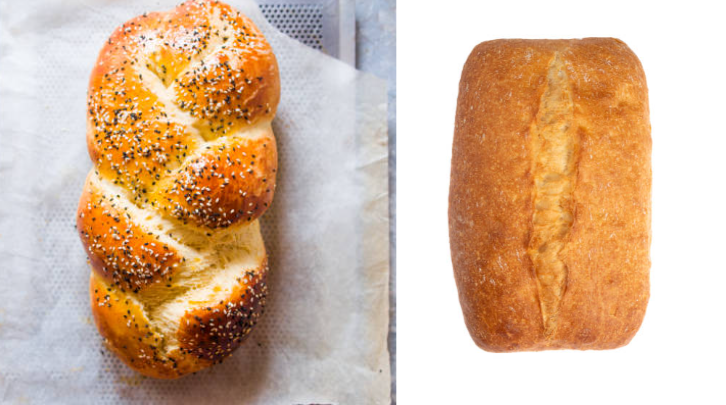Challah Vs. Ciabatta: The Baking Battle You Can’t Miss

What To Know
- However, ciabatta tends to have a slightly lower glycemic index than challah, meaning it may cause a slower rise in blood sugar levels.
- Challah’s mild flavor and versatility make it a crowd-pleaser, while ciabatta’s bold flavor and rustic charm appeal to those who appreciate a more assertive bread.
- Store challah and ciabatta in an airtight container at room temperature for up to 2 days.
In the realm of bread, two titans stand tall, each with its unique charm and devoted following: challah and ciabatta. These delectable loaves have captivated taste buds for centuries, leaving bread enthusiasts in a perpetual state of indecision. This blog post delves into the depths of the challah vs ciabatta debate, exploring their origins, characteristics, and culinary versatility. Embark on a journey of discovery as we unravel the mysteries that set these two bread masterpieces apart.
Origin and History: A Tale of Two Cultures
Challah, a braided bread with a rich Jewish heritage, traces its roots back to ancient times. It holds a significant place in Jewish tradition, often adorning the Shabbat table and symbolizing unity and celebration. Ciabatta, on the other hand, emerged from the heart of Italy in the 1980s. Inspired by traditional Italian bread-making techniques, ciabatta quickly gained popularity for its distinctive airy texture and rustic appearance.
Appearance: A Visual Feast for the Eyes
Challah’s beauty lies in its intricate braids, often adorned with poppy seeds or sesame seeds. Its golden-brown crust and soft, fluffy interior create a visually appealing loaf. Ciabatta, with its characteristic oblong shape and large air pockets, exudes a rustic charm. Its crust is typically thinner and crispier than challah’s, adding a delightful crunch to every bite.
Texture and Taste: A Symphony of Sensations
Challah’s texture is soft and pillowy, with a slight chewiness that adds depth to its flavor. Its mild, slightly sweet taste makes it a versatile bread that pairs well with various toppings and fillings. Ciabatta, known for its airy and open crumb, offers a crispy crust that yields to a soft, chewy interior. Its flavor is bolder and more pronounced than challah’s, with a hint of sourdough tang.
Culinary Versatility: A Bread for Every Occasion
Challah’s versatility shines through in its ability to transform into a variety of culinary delights. It serves as the foundation for French toast, bread pudding, and challah rolls. Its mild flavor makes it an ideal accompaniment to savory dishes like sandwiches, soups, and stews. Ciabatta’s crusty exterior and chewy interior make it a perfect choice for paninis, bruschetta, and croutons. Its bold flavor stands up well to robust ingredients, making it a popular choice for sandwiches and grilled dishes.
Nutritional Value: A Comparison of Health Benefits
Challah and ciabatta offer a similar nutritional profile, with carbohydrates being the primary macronutrient. However, ciabatta tends to have a slightly lower glycemic index than challah, meaning it may cause a slower rise in blood sugar levels. Both breads provide some dietary fiber, which is beneficial for digestive health.
The Verdict: A Matter of Personal Preference
In the great challah vs ciabatta debate, there is no clear victor. The choice ultimately depends on personal preference and the intended use. Challah’s mild flavor and versatility make it a crowd-pleaser, while ciabatta’s bold flavor and rustic charm appeal to those who appreciate a more assertive bread.
A Culinary Exploration: Recipes to Delight Your Palate
To truly appreciate the culinary wonders of challah and ciabatta, embark on a journey of taste through these tantalizing recipes:
- Challah French Toast: Transform your challah into a decadent breakfast or brunch treat.
- Challah Bread Pudding: Indulge in a comforting and flavorful dessert that showcases challah’s soft and fluffy texture.
- Ciabatta Panini: Create a savory and satisfying sandwich with ciabatta as the foundation.
- Ciabatta Bruschetta: Top crispy ciabatta slices with fresh tomatoes, basil, and a drizzle of olive oil for a classic Italian appetizer.
- Ciabatta Croutons: Elevate your salads and soups with homemade ciabatta croutons, adding a delightful crunch and flavor.
What You Need to Know
1. Which bread is sweeter, challah or ciabatta?
- Challah tends to have a slightly sweeter flavor compared to ciabatta.
2. Can I substitute challah for ciabatta in recipes?
- Yes, you can often substitute challah for ciabatta in recipes, although the flavor and texture may vary slightly.
3. How do I store challah and ciabatta to maintain freshness?
- Store challah and ciabatta in an airtight container at room temperature for up to 2 days. For longer storage, freeze the bread for up to 2 months.
4. What are some popular fillings or toppings for challah and ciabatta?
- Challah pairs well with sweet fillings like cinnamon sugar, chocolate chips, or fruit preserves. Ciabatta is a great choice for savory fillings like roasted vegetables, cured meats, and cheeses.
5. Can I make challah or ciabatta at home?
- Yes, both challah and ciabatta can be made at home with the right ingredients and techniques. There are numerous recipes and tutorials available online to guide you through the process.